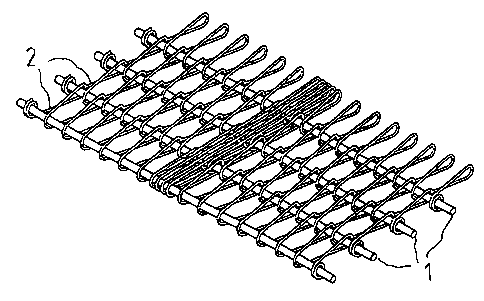Some of the information on this Web page has been provided by external sources. The Government of Canada is not responsible for the accuracy, reliability or currency of the information supplied by external sources. Users wishing to rely upon this information should consult directly with the source of the information. Content provided by external sources is not subject to official languages, privacy and accessibility requirements.
Any discrepancies in the text and image of the Claims and Abstract are due to differing posting times. Text of the Claims and Abstract are posted:
| (12) Patent: | (11) CA 2295033 |
|---|---|
| (54) English Title: | A WIRE MESH CONVEYOR BELT |
| (54) French Title: | BANDE TRANSPORTEUSE MAILLEE METALLIQUE |
| Status: | Expired and beyond the Period of Reversal |
| (51) International Patent Classification (IPC): |
|
|---|---|
| (72) Inventors : |
|
| (73) Owners : |
|
| (71) Applicants : |
|
| (74) Agent: | SMART & BIGGAR LP |
| (74) Associate agent: | |
| (45) Issued: | 2007-08-28 |
| (86) PCT Filing Date: | 1998-06-22 |
| (87) Open to Public Inspection: | 1998-12-30 |
| Examination requested: | 2003-04-03 |
| Availability of licence: | N/A |
| Dedicated to the Public: | N/A |
| (25) Language of filing: | English |
| Patent Cooperation Treaty (PCT): | Yes |
|---|---|
| (86) PCT Filing Number: | PCT/SE1998/001202 |
| (87) International Publication Number: | SE1998001202 |
| (85) National Entry: | 1999-12-21 |
| (30) Application Priority Data: | ||||||
|---|---|---|---|---|---|---|
|
A conveyor belt comprises a plurality of side links at each side of the
conveyor belt, a plurality of transverse rods connecting the
side links in pairs, and a wire mesh forming a conveying surface of the
conveyor belt. The wire mesh further comprises a plurality of
wire spirals each spiral having loops encircling two of the transverse rods.
At least some of the wire spirals have a varying pitch along the
length of the rods.
L'invention concerne une bande transporteuse comprenant, de chaque côté, une pluralité de maillons latéraux. Une pluralité de barres transversales relient les maillons latéraux par paires et un treillis métallique forme la surface de transport de la bande transporteuse. Le treillis métallique comprend également une pluralité de spirales, chaque spirale ayant des boucles encerclant deux des barres transversales. Au moins certaines spirales ont un pas variable sur la longueur des barres transversales.
Note: Claims are shown in the official language in which they were submitted.
Note: Descriptions are shown in the official language in which they were submitted.

2024-08-01:As part of the Next Generation Patents (NGP) transition, the Canadian Patents Database (CPD) now contains a more detailed Event History, which replicates the Event Log of our new back-office solution.
Please note that "Inactive:" events refers to events no longer in use in our new back-office solution.
For a clearer understanding of the status of the application/patent presented on this page, the site Disclaimer , as well as the definitions for Patent , Event History , Maintenance Fee and Payment History should be consulted.
| Description | Date |
|---|---|
| Time Limit for Reversal Expired | 2015-06-22 |
| Letter Sent | 2014-06-23 |
| Grant by Issuance | 2007-08-28 |
| Inactive: Cover page published | 2007-08-27 |
| Inactive: Final fee received | 2007-06-05 |
| Pre-grant | 2007-06-05 |
| Notice of Allowance is Issued | 2007-04-18 |
| Letter Sent | 2007-04-18 |
| Notice of Allowance is Issued | 2007-04-18 |
| Inactive: Approved for allowance (AFA) | 2007-03-16 |
| Amendment Received - Voluntary Amendment | 2006-06-09 |
| Inactive: IPC from MCD | 2006-03-12 |
| Inactive: S.30(2) Rules - Examiner requisition | 2005-12-13 |
| Inactive: IPC assigned | 2005-11-24 |
| Letter Sent | 2003-05-14 |
| Amendment Received - Voluntary Amendment | 2003-05-05 |
| Request for Examination Received | 2003-04-03 |
| Request for Examination Requirements Determined Compliant | 2003-04-03 |
| All Requirements for Examination Determined Compliant | 2003-04-03 |
| Inactive: Cover page published | 2000-02-29 |
| Inactive: First IPC assigned | 2000-02-25 |
| Letter Sent | 2000-02-10 |
| Inactive: Notice - National entry - No RFE | 2000-02-10 |
| Application Received - PCT | 2000-02-04 |
| Application Published (Open to Public Inspection) | 1998-12-30 |
There is no abandonment history.
The last payment was received on 2007-05-31
Note : If the full payment has not been received on or before the date indicated, a further fee may be required which may be one of the following
Patent fees are adjusted on the 1st of January every year. The amounts above are the current amounts if received by December 31 of the current year.
Please refer to the CIPO
Patent Fees
web page to see all current fee amounts.
Note: Records showing the ownership history in alphabetical order.
| Current Owners on Record |
|---|
| FRIGOSCANDIA EQUIPMENT AB |
| Past Owners on Record |
|---|
| INGEMAR FRODERBERG |